The Mainstream
All of Michigan's rivers drain into one of the Great Lakes.
For that reason the majority of its rivers are rather short.
The Grand River is Michigan's longest. It begins south of
the city of Jackson and flows north and then west for about
250 miles to Lake Michigan. The river actually begins
closer to Lake Erie but meanders to the west instead.
The Grand begins as a very slow-moving stream and continues
this way for about 30 miles. The low gradient results in a
soft bottom making the river difficult to wade. The river
is floatable but the fishing is only fair with northern pike,
walleye, and largemouth and smallmouth bass the principal
game fish. As the Grand nears the small town of Eaton Rapids
it begins changing to a classic smallmouth bass stream.
It widens, the flow quickens, the bottom firms up, and
boulders poke their round tops above the surface of the
water. Eaton Rapids was named for the character of the
river here and proclaims itself as the "only Eaton Rapids
on Earth."
Except for where it is impounded, the Grand continues to
alternate riffles with pools and contains boulder-strewn
runs all the way to the city of Grand Rapids. This is
the prime fly fishing reach of the river. Most of the
dams on the river are relatively low head, but three
hydroelectric dams (Smithville, Moores Park, and Webber)
do create substantial backwaters. The areas below each
dam offer prime fly fishing opportunities. Access is
good at each dam and there is usually a good concentration
of fish below each barrier. The two main reasons for the
increased numbers are the blockage of fish movement and
the presence of disoriented or injured baitfish that have
just passed over the dam or through its turbines. Of
course anglers can also be concentrated at these locations
and you may do better by trying stretches that receive
less pressure.
Many road bridges provide additional access as do the
developed public access sites with launch ramps which
are shown on maps of the river. The Portland State Game
Area, just upstream from the town of Portland, provides
a number of additional access locations. Canoes and
kickboats can be launched
at many points where launch ramps are not present. You
can exercise lots of smallmouth, with a few walleyes and
channel catfish thrown into the mix. At normal summer
flows you can also safely navigate the river in a float
tube or personal watercraft. If you like to cover lots
of water, try launching at Charlotte Highway and then
float through the entire state game area. The riverside
park in Portland provides a good place to take out.
Other prime floats in this section of the Grand include
Fitzgerald Park in Grand Ledge to State Road or Jones
Road to Turner Road.

Prime months for the Grand River's Resident fish are
May through September although most species remain active
into October until the water temperature falls below 50
degrees. Walleyes can be caught throughout the year but
they will hit better when the water is above 45 degrees.
The Grand's second season - the first in the minds of
many anglers - begins as soon as the river water temperature
cools into the 60s in late August or September.
There are five species of anadromous salmon and trout
that run the Grand River System each year and we will
discuss those fisheries after we describe the dam areas
in greater detail and the Grand's major tributaries.
Sixth Street Dam
Before we describe the rapids below Sixth Street Dam in
detail it is important to talk about water levels. During
low flows all of the rapids are accessible to wading
anglers but as the river rises, one must limit his or
her wading to certain locations. There is a staff
gauge on the ladder structure above the ladder and
there is a United States Geological Survey gauge in
the lower rapids. . .The USGS reading is available
on the Internet
http://wwwdmilns.er.usgs.gov/ but you must read
the staff gauge at the ladder.
The prime fly fishing areas near the dam are Center Run
and the Flats. The Flats are found on the eastern side
of the river and are a shallow, fast sweep of water over
bedrock just below the dam. The remnants of icebreakers
on the dam delineate the center of the river. On the
western side, the water is much deeper and the area
near the dam is called the boils. You can fish the
tail out of these boils if you can find space to fish.
The Center run is named for its location and it is where
the main flow of the river occurs. There are three
slightly deeper areas or dips in the Center Run where
the fish tend to lie and you will learn their locations
as you fish it...
Just above the x-way there is a traverse trough that
extends almost the whole width of the river. You can't
wade through it but you can fish above and below it.
There is a large bridge (Bridge Street) between the first
and second coffers and its abutments provide cover for
both resident and anadromous fish. Wading can be tough
here because of strong currents and an uneven bottom.
Use your wading staff but don't try it if the water
level is at 5.7 or above.
Lyons Dam
Access is available on each side of the river below the
Lyons Dam. (Fish hold and feed near the dam and below
the apron.) To fish the apron area below the dam it
is best to enter the river from the eastern or ladder
side. The bridge just below the dam also deserves
lots of attention, especially the first two areas
between pillars on the western side. Below the bridge,
the main flow and deeper water is on the western side
of the river. You can roll cast from shore, or wade
out from the eastern side, when the water is not too
high. This run angles to the center of the river and
tails out below the power lines. Swinging streamers
in the tail out is a good plan for both resident and
anadromous fish.
Webber Dam
There is a public access site on the eastern side of
the river that can be reached from Maple Road and then
Park Boulevard. A prime area to fish is below the
cofferdam. When the water is relatively low, with
only one turbine running on the dam, you can wade
all the way across the river here and swing streamers
or drift nymphs downstream, but you will need to return
to shore to wade further downstream. An excellent run
is found between the end of the wall that separates
the turbines from the overflow gates down to a large
island. Fish continue to hold all along both sides
of the island as well.
Portland Dam
The ladder at the Portland Dam is on the south side of
the river and there is a public access site there. The
power channel can hold fish but the better fly fishing
is found in the main river. At modest water levels you
can walk downstream to where the channel tails out and
cross it to the rocky main flow. From here, you can wade
almost up to the dam. With a wading staff and great care
you can cover most of the water below the dam.
Fitzgerald Dam.
Located inside of Fitzgerald Park in Grand Ledge, this dam
is the most ideal site for the fly fisher. Under normal flows,
water depths range from two to five feet. The deeper slots
are located along the apron of the spillway. . .Below the
pool is a major run that is 50-yards long which sweeps
along the park's edge. Migratory resident and non-resident
fish stage and feed in this area prior to upstream movement.
The entire layout of this dam site looks intimidating, but
with the assistance of a wading staff, felt bottom waders
and polarized glasses, the area below Fitzgerald Dam is
excellent fly water.
Red Cedar River
The Red Cedar River joins the Grand in the city of Lansing
and is the first major tributary to add its flow to the
mainstream. The prime water for both resident and
anadromous fish is between the town of Williamston
and the river's mouth. A dam in Williamston has been
modified to provide a short run of white water rapids
for paddle sport enthusiasts and the entire stretch
of the river is floatable by canoe or small boat.
The Red Cedar can be easily waded at normal levels,
except for a mile or two above a low head dam on the
Michigan State University campus, and the last three
miles above the confluence with the Grand, where the
North Lansing Dam impounds the tributary.
Looking Glass River
. . .Once the Looking Glass passes under U.S. 27 it has
a firm gravel and cobble bottom with numerous large
boulders. This is classic smallmouth water and the
river maintains this character all the way to its
confluence with the mainstream in Portland.
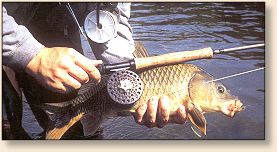 You can expect multiple hook-ups in the good holes
in the Looking Glass and fishing them in an upstream
direction will increase your action. Try to steer
your hooked smallies and pike downstream and out of
the pool, if possible, so as to not spook the other
fish. Sight fishing for carp is also more successful
in an upstream direction as these fish are very wary.
You can expect multiple hook-ups in the good holes
in the Looking Glass and fishing them in an upstream
direction will increase your action. Try to steer
your hooked smallies and pike downstream and out of
the pool, if possible, so as to not spook the other
fish. Sight fishing for carp is also more successful
in an upstream direction as these fish are very wary.
Maple River
The Maple River is the next major tributary to the Grand,
and again, it too joins the mainstream from the north.
Even during dry weather, the Maple suffers from high
turbidity due to the soil types in its drainage basin.
This is really unfortunate for the fly anglers because
there is a good population of channel catfish along
with some flatheads and walleyes. Pike and smallmouth
bass are also present.
Flat River
The Flat River joins the Grand in the town of Lowell
and is a fine smallmouth bass stream. A special attribute
of the Flat is that it is the slowest to muddy, and the
quickest to clear, after a heavy rain on any of the Grand
River tributaries. In addition, moderate rains don't seem
to affect its fishability. This makes the Flat River your
insurance policy when it rains hard and the other rivers
are too muddy.
Even though the Flat is basically a warm water river,
there is a chance to catch brook trout in it during
the springtime. There are several small brook trout
creeks north of Greenville that feed the Flat, and
brookies up to 16 inches move down into the main
river to feed. Usually the water temperature stays
cool enough for them until late May.
|

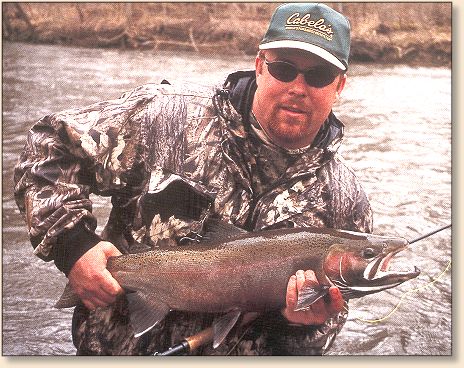
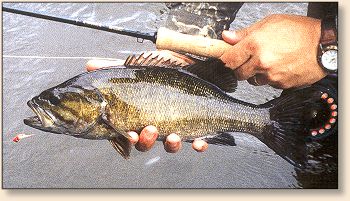
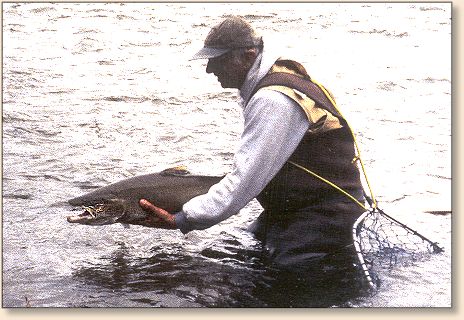
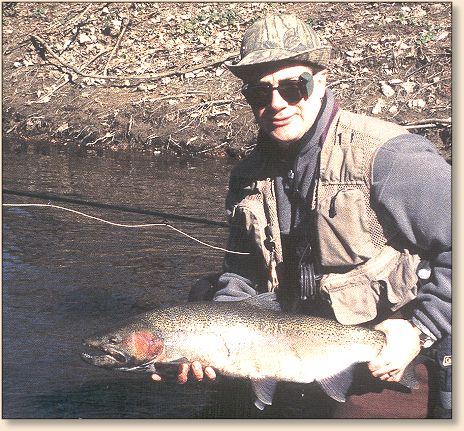

 You can expect multiple hook-ups in the good holes
in the Looking Glass and fishing them in an upstream
direction will increase your action. Try to steer
your hooked smallies and pike downstream and out of
the pool, if possible, so as to not spook the other
fish. Sight fishing for carp is also more successful
in an upstream direction as these fish are very wary.
You can expect multiple hook-ups in the good holes
in the Looking Glass and fishing them in an upstream
direction will increase your action. Try to steer
your hooked smallies and pike downstream and out of
the pool, if possible, so as to not spook the other
fish. Sight fishing for carp is also more successful
in an upstream direction as these fish are very wary.